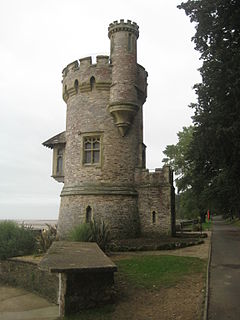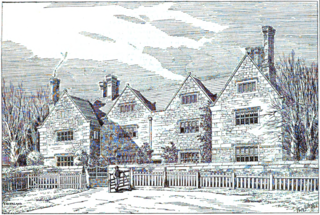Related Research Articles

Ryde is an English seaside town and civil parish on the north-east coast of the Isle of Wight. The built-up area had a population of 23,999 according to the 2011 Census and an estimate of 24,847 in 2019. Its growth as a seaside resort came after the villages of Upper Ryde and Lower Ryde were merged in the 19th century, as can still be seen in the town's central and seafront architecture. The resort's expansive sands are revealed at low tide. Their width means the regular ferry service to the mainland requires a long listed pier – the fourth longest in the United Kingdom, and the oldest surviving.
Sir William Hutt, KCB, PC was a British Liberal politician who was heavily involved in the colonisation of New Zealand and South Australia.

Appley is an area of Ryde on the Isle of Wight.. Until the early 1960s, it was largely based on the former English country house of Appley Towers and neighbouring Appley Farm. The area's character changed with the construction of the Appley housing estate – a development of mainly detached houses and bungalows, built on either side of the B3330 Ryde to St Helens road. The names of the roads on the estate relate mostly either to proximity of the sea or refer to Cumbrian lakes. The area to the north of the Appley housing estate is now a public park, with the Solent beyond. The stone-built tower by the sea wall dates from the days this land was the property of the Hutt family, as does the parkland itself, the latter being laid out to a design by Humphry Repton in 1798. In 2008, Appley Park became the first open space on the Isle of Wight to be awarded a Green Flag. The large villa just off the B3330 road, known previously as "Little Appley" at one time accommodated a school, as shown by the remaining sports field which adjoins it. This field is the home of archery club Wight Bowmen. The former school building now operates as a hotel and restaurant under the name Appley Manor. Appley House was the residence of Mr. Clayton.
Sir George Hutt was a British Indian Army officer.

The Isle of Wight Coastal Path is a circular long-distance footpath of 70 miles (113 km) around the Isle of Wight, UK. It follows public footpaths and minor lanes, with some sections along roads.

Elmfield is a suburb of the town of Ryde on the Isle of Wight, in England. It is situated south-east of the town centre on a small hill. St John's Church is a notable landmark on the north side of Elmfield. Oakfield lies directly to the West, Appley to the North, Seaview and Nettlestone to the East and Westridge to the South.

Carisbrooke Priory was an alien priory, a dependency of Lyre Abbey in Normandy. This was dissolved in around 1415. priory was situated on rising ground on the outskirts of Carisbrooke close to Newport on the Isle of Wight. A second Carisbrooke Priory was created in 1993, when St. Dominic's Priory, which had been established as a community of Dominican nuns in 1865–66 was so renamed.

Puckpool is a small coastal settlement on the outskirts of Ryde on the Isle of Wight. The area is best known for Puckpool Park, a park with an 18-hole putting green, 12 hole mini golf and two tennis courts. Puckpool Battery is located within the boundaries of the park; this is an old Palmerston Fort built in 1865.

St Cecilia's Abbey, Ryde is an abbey of Benedictine nuns in the Isle of Wight, England.

Nunwell House, also Nunwell Manor, is a historic English country house in Brading, Isle of Wight. Located 3 miles (4.8 km) south of Ryde, the Tudor and Jacobean style house also has later additions. The house contains family militaria. It was occupied by the Oglander family from Norman times until 1980. Nunwell House is a Grade II* listed building.
Billingham Manor is a manor house lying about a mile south of the village of Chillerton on the Isle of Wight.

Northcourt Manor is one of three manor houses, along with Woolverton and Westcourt, that is located in Shorwell, on the Isle of Wight, England. It was begun by Sir John Leigh, Deputy Governor of the Island, in 1615, but was unfinished at his death. Northcourt is currently in use as a hotel.
St. Clare Castle was a castellated mansion in Appley on the Isle of Wight. It was the family seat of St Clare, Appley. Her Majesty Queen Victoria and the Prince Consort visited several times, while Princess Alice and Prince Louis honeymooned at St. Clare in 1862. St. Clare Castle is situated on the coast, about a mile east of Ryde. It was the seat of Colonel Francis Vernon-Harcourt. The grounds and gardens are extensive.

Appley Towers, also called Appley Tower or Appley Tower House was an English country house near Appley House in Appley, Isle of Wight. It was the home of the Hutt family, who bought it in the 1870s, and later of Sir Hedworth Williamson. The house has been demolished, but a number of its estate buildings survive.

Yaverland Manor is a medieval manor house in Yaverland, near Sandown, on the Isle of Wight. It was reconstructed in c. 1620 with alterations c. 1709. It became a Grade I listed building in 1949.

Sheat Manor is a manor house in Chillerton, on the Isle of Wight, England. Considered to be one of the island's antiquities, Sheat manor house, is a fine old gabled mansion now used as a farmhouse. It has a pond and swans. It contains some interesting Jacobite carving. Sheat was one of the few properties whose Anglo-Saxon owner, Alaric, was not disturbed by the Norman invasion. It was run by the Urry family for some time.
Landguard Manor is a manor house in Shanklin on the Isle of Wight, England. Mentioned in the Domesday Book, over the centuries it was home to numerous notable gentlemen. It is a Grade II listed building. One of the finest known portraits by Sir Thomas Lawrence, English portrait painter and president of the Royal Academy, is located in its drawing room.
George Alexander Hillier (1815–1866) was an English antiquarian.

Thomas Hellyer was an English architect of the mid-Victorian era. He was based on the Isle of Wight and was "the leading Island-based architect of the period", but his works can also be found on the mainland—principally in Hampshire—but also further afield. Described by Pevsner as a "very individualistic" and "remarkable" architect, his output included churches, houses, schools and hospitals across the island, during a period of rapid urban development. Many of his buildings have listed status and he "made important contributions to the appearance of the city" of Portsmouth through his extensive work in the area.
St or St. Cecilia's Abbey may refer to:
References
- ↑ Elford, June; Gascoigne, Steve (2004). Isle of Wight Gem of the Solent. Coach House Publications Ltd. p. 11. ISBN 978-1-899392-33-9.
- ↑ Lloyd, David Wharton; Pevsner, Nikolaus (2006). The Isle of Wight. Yale University Press. p. 227. ISBN 978-0-300-10733-3.
- This article includes text incorporated from Henry Irwin Jenkinson's "Jenkinson's practical guide to the Isle of Wight (1876)", a publication now in the public domain.
- This article includes text incorporated from Thomas Brettell's "Handbook to the Isle of Wight (1844)", a publication now in the public domain.